We are connected to the internet virtually everywhere. Grocery stores, public transit, and your local library likely offer public Wi-Fi. However, while this is a convenient option, it might not be the most secure. Today, we will take a quick look at the dark side of public connectivity.
What’s The Problem?
The most glaring concern with public Wi-Fi is its inherent lack of security. While many networks are considered safe, others go completely unencrypted. This means that anybody with a little technical knowledge under their belt could potentially open a spying eye on your online activity. Consider it an invisible villain standing over your shoulder that’s able to view what you’re doing from typing passwords to checking your bank account.
Types Of Threats
In addition to simple eavesdropping, public Wi-Fi can be a breeding ground for malware. Security-savvy hackers can easily create faux hotspots that look like the real deal. Once you have been tricked into connecting, your device is open for malware and data compromise.
Other concerns include session hijacking and man-in-the-middle attacks. A session hijacking happens when cybercriminals steal “cookies” from your network that allow them to put on a digital disguise and access your accounts without your password or security codes. A man-in-the-middle attack is essentially a cyber thief standing between you and your hotspot using tools to steal and manipulate login credentials, private data, and more. (If you’ve ever played the classic children’s game “Monkey in the Middle,” think of the ball as your data and the middle person as the hacker.)
Keeping Yourself Safe
There are many ways to keep yourself secure while on a public network. This includes utilizing a VPN and disabling the auto-connect feature on your devices. You also want to ensure that each device that you use on a public connection is up to date with a current and enabled firewall. Most importantly, avoid connecting to Wi-Fi networks that you don’t know. Remember, a legitimate business/hotspot will have that information posted and likely won’t have alternate names. Utilize two-factor authentication and invest in a mobile hotspot to create your own Wi-Fi connection if you frequently access the internet from a public space.
Still have questions about using public Wi-Fi? Contact ITC today and let our digital technology experts help you come up with a plan that keeps your personal and professional credentials safe.





